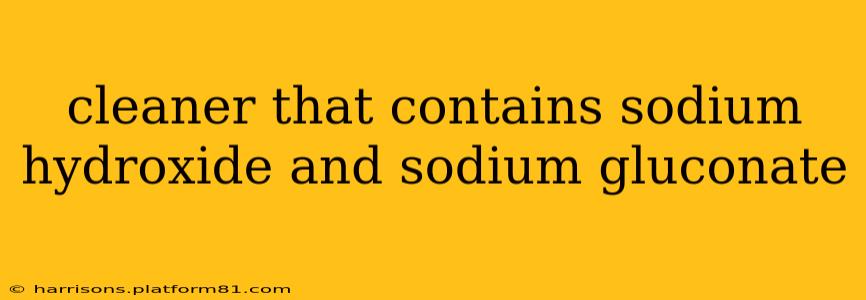Many cleaning products utilize a combination of chemicals to achieve effective cleaning power. A common pairing is sodium hydroxide (NaOH), also known as lye or caustic soda, and sodium gluconate. Understanding the role of each ingredient and their combined effect is crucial for safe and effective use. This article delves into the properties of these two chemicals, their application in cleaning solutions, and answers frequently asked questions.
What is Sodium Hydroxide (NaOH)?
Sodium hydroxide is a highly alkaline substance, meaning it has a high pH level. Its strong alkalinity makes it an effective degreaser and cleaner, capable of dissolving fats, oils, and greases. This is why it's frequently found in drain cleaners, oven cleaners, and other heavy-duty cleaning products. However, it's crucial to remember that sodium hydroxide is corrosive and can cause serious skin and eye damage if not handled properly. Always follow the manufacturer's instructions carefully and wear appropriate protective gear, including gloves and eye protection.
What is Sodium Gluconate?
Sodium gluconate is a chelating agent, meaning it binds to metal ions in hard water. These metal ions can interfere with the effectiveness of cleaning agents and can leave unsightly stains. By binding to these ions, sodium gluconate helps to prevent scaling and improve the performance of other cleaning components, such as the sodium hydroxide. It also acts as a buffer, helping to stabilize the pH of the cleaning solution. This is particularly beneficial in formulations containing strong alkalis like sodium hydroxide, as it can help to mitigate some of the corrosive effects.
Why are Sodium Hydroxide and Sodium Gluconate Used Together?
The combination of sodium hydroxide and sodium gluconate in cleaning products creates a synergistic effect. The sodium hydroxide provides the powerful cleaning action, while the sodium gluconate enhances its performance and helps to prevent unwanted reactions or residue. This pairing allows for a more effective and efficient cleaning process, especially in situations where hard water or stubborn grease is present.
What are the benefits of using a cleaner with sodium hydroxide and sodium gluconate?
The benefits include enhanced cleaning power due to the combined action of the strong alkali and the chelating agent. This leads to improved grease removal, reduced scaling from hard water, and potentially a more environmentally friendly formulation (as lower concentrations of the harsh sodium hydroxide may be needed).
Is a cleaner containing sodium hydroxide and sodium gluconate safe?
No, a cleaner containing sodium hydroxide is not safe if mishandled. While sodium gluconate contributes to a safer formulation by stabilizing the pH and reducing some of sodium hydroxide's harshness, sodium hydroxide remains a corrosive substance. Always wear appropriate personal protective equipment (PPE) like gloves and eye protection. Follow the manufacturer's instructions precisely, and ensure adequate ventilation when using these products.
What types of cleaning applications benefit from this combination?
This combination is particularly effective for heavy-duty cleaning applications involving grease, oil, or hard water. Examples include industrial cleaning, drain cleaning, and certain types of oven cleaners.
Are there any environmental concerns with using this type of cleaner?
The environmental impact depends largely on responsible disposal and usage. Sodium hydroxide is a strong alkali and can harm aquatic life if improperly disposed of. Always follow local regulations for disposal of cleaning chemicals. The inclusion of sodium gluconate, while not inherently environmentally damaging, doesn't negate the need for careful usage and disposal of the sodium hydroxide component.
This combination provides a powerful and effective cleaning solution, but proper safety precautions are paramount due to the corrosive nature of sodium hydroxide. Always read and follow the manufacturer's safety instructions carefully.
